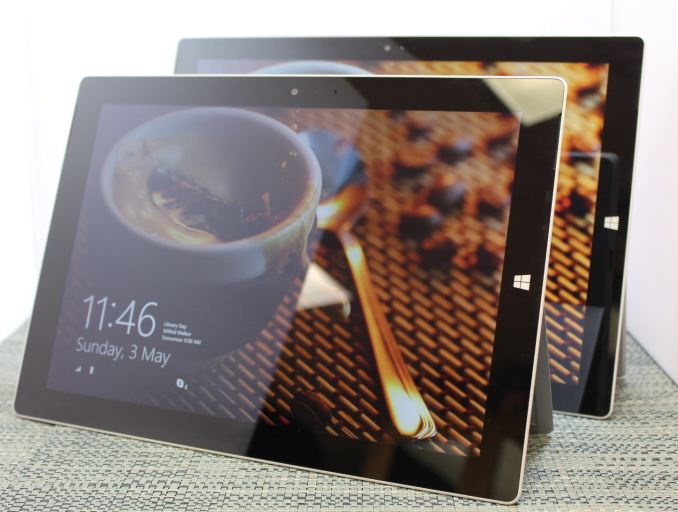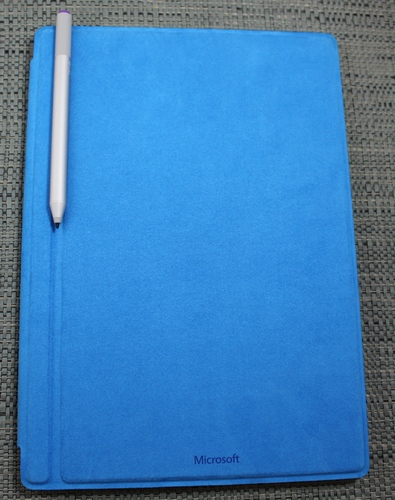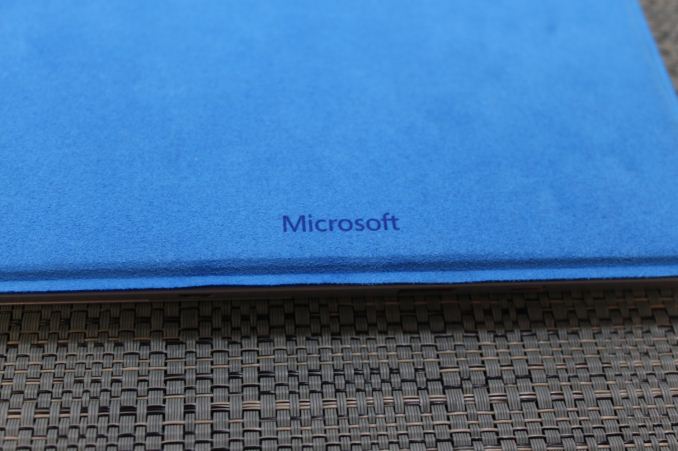The Surface 3 Review
by Brett Howse on May 4, 2015 9:00 AM ESTFinal Words
In the Windows space, there is quite a bit of variety in tablets. Some are well under $100, and some go over $1000. In this space, the Surface Pro 3 has done very well, establishing a name for itself with good performance in a small form factor. Microsoft is certainly trying to emulate this success with the Surface 3, and for good reason. With the Surface Pro 3, they got a lot right, so it makes sense to push the value line in the same direction.
The Surface 3 is superior to its predecessors in many ways. Where they were good, it is better. It keeps the wonderful magnesium chassis, but stretches it into a 3:2 aspect ratio. This alone is almost worth the price of admission, but it is just one of many changes made. I would argue that it is one of the most important changes to this tablet, and it makes it a better tablet and a better laptop. The kickstand has always been a staple of the Surface lineup, and adding the one additional step really helps make it even more usable in more scenarios. I wish it opened just a bit wider like the Pro model does, but that is a small gripe.
The move to x86 with the Atom x7-8700 was long needed. No longer is Surface and Surface Pro not able to run the same applications. Windows RT was always going to be a tough sell, but even more so since the Windows Store did not take off as quick as would have been necessary for RT to have a future. Once Intel shipped Bay Trail though, the writing was on the wall for Windows RT, since there was little reason to sacrifice the backwards compatibility of x86. The move to Cherry Trail in this model has provided a speed boost as well, and for light workloads it is more than sufficient. Plus, you could run anything that a Surface Pro could run, even if it will take a bit longer. That is an option that just did not exist before with the Surface line.
That being said, the SoC performance is where the price point dictates - around the good ARM products but poorer compared to Core. This is especially true when compared to the Surface Pro 3, but it is worth noting the SoC power draw between the two (14W vs 2W). That being said, the performance of the eMMC is a major drawback to how this device feels, especially in day to day use. Most of the time it isn't noticable, but when there is a bottleneck most of the time it was due to disk accesses.
From a long term usability standpoint, getting rid of the 32 GB model and having Surface 3 start with 64 GB is a big boost. 32 GB is a tough sell when you have the larger install footprint of Windows, as well as a recovery partition. Add in some Windows Updates, and a 32 GB model is going to be near capacity right away, and that really diminishes eMMC’s performance. Now the base model starts at 64 GB, and for just $100 more, you can opt for the 128 GB model which also has 4 GB of RAM. I personally think that would be $100 well spent, and if I was buying, that would be the model I would go for.
The accessories are also first rate. The keyboard is really quite good, and although the trackpad is small, it does work well when needed. It is a bit on the pricey side but it really does complete the Surface 3 and gives you the laptop capabilities in a nice cover. When I was using it as a tablet, I almost always removed the keyboard though, so it is certainly not a must have, but a really should have. Adding the pen to the lineup for this round was also a great move. Being able to use the Surface 3 for quick notes came in very handy, and I found the pen to be quite easy to glide over the screen, and accuracy was top notch. Of the accessories, the dock is likely not something the average consumer needs, but it really is a nice dock for storage and charging. At $199 though, it is too much for the average person to go for. For businesses though, it should come in very handy and should help the Surface 3 gain some traction there. It is not quite as good as the Surface Pro’s dock though, since this model lacks the proprietary docking port of the Surface Pro 3.
There is a lot to like about the Surface 3, but not everything is perfect. Battery life, especially when compared to other tablets, is well below average. This is despite having a display with a pixel density less than a lot of the competition, which means the Surface 3 should have an advantage in backlight power consumption. Display power draw is a huge concern, and perhaps the Panasonic one in the Surface 3 is not quite as efficient as others, especially Sharp’s IGZO lineup. The overall battery life is still decent though, and the much improved standby time is a big boon. However the charge rate is really a problem on this tablet, and it would have been excellent to see this new device embrace USB Type-C as the charging connector. Since it already has a full sized USB 3.0 port, there would be very little downside to moving to the new connector for charging, and it would allow for a reversible insertion as well.
I think though that the battery life is really the only real concern for the Surface 3. In the Windows space, there is no other tablet quite like this one, except maybe the Surface Pro 3, but that device is bigger, and heavier, and less useful as a tablet. It does have far more performance available, but for far more money up front.
Up to this point, I have not discussed the ability to use Surface 3 in your lap at all, and for good reason. For people out in the world that need to be able to use a device in their lap, then please just buy a notebook computer. Almost none of the 2-in-1 devices that I have tested have been especially good at that task, even those with true attachable keyboards. Only the devices like the Yoga 3 Pro which keep the processor in the base have the correct balance for this task. The Surface 3 can work in a pinch, but it is much better suited to be used on a desk with the keyboard attached if you need to use it as a notebook.
Pricing is the final piece of the puzzle. At $499, you get a decent spec with 2 GB of memory and 64 GB of storage. The $599 model bumps that to 4 GB of memory and 128 GB of storage. It is not inexpensive. Add in the keyboard for another $130 and the Surface 3 is getting close to the pricing of the ASUS UX305, which has a lot more performance available. The pen is another $50 on top. The base price of the Surface 3 is, I think, competitive, but adding in the accessories to really make it what it is advertised as ramps the price up in a hurry.
So with those caveats aside, we can finally get to the conclusion that you have likely guessed already. The Surface 3 is a great device. The build quality is really at the top level of any OEM out there. The form factor is finally the right one after two previous generations that got it slightly wrong. The weight is lighter than any previous Surface, and just as balanced. Performance of the x7 Atom CPU is great for light tasks, and if you need more than light tasks then this is not the device for you. As a tablet, it is great to use in either orientation, with the portrait mode being especially good now for browsing the web. The kickstand is improved, they keyboard is improved, the base tier steps up to 64 GB of storage, making it actually useful without immediately adding micro SD to the mix.
With Windows 10 right around the corner, the Surface 3 feels like Microsoft’s best attempt yet at creating a great tablet computer. If you in the market and you want a Windows 8.1 tablet, it would be worth your time to check out the Surface 3.













265 Comments
View All Comments
khanikun - Friday, May 8, 2015 - link
I have an SP3 and it's big selling point over essentially everything you mentioned, the ability to actually make it a tablet. I don't need a keyboard strapped on the thing 24/7, nor do I want to put the keys in harms way when converted into tablet form.I use it like a laptop when I hit my destination and I rip the keyboard off it, when walking around or having it put into my tablet mount in the car. If it were a convertible laptop, I probably would have lost a few keys by now.
Rebelismo - Tuesday, May 12, 2015 - link
Yeah. Lack of apps... That's a good one.There is a clear chasm nowadays between content consumers, and professional users. It seems that MOST people would be fine with a social media content device. The way I see it, the Surface line was made for engineers, designers, scientists, artists etc. If you're worried that the windows store might not have Snapchat, then please get yourself a nice android or ios phablet.
eagle63 - Sunday, May 17, 2015 - link
"...the Surface line was made for engineers, designers, scientists, artists etc...." Those people primarily use Macs, not Windows. Windows is for corporate-types who push spreadsheets around all day. :) Obviously I'm generalizing but I'm not that far off the mark.If you're looking at a Windows tablet and honestly intend to use it as a tablet, then yes there is a remarkable lack of apps - I actually can't believe you would think otherwise. (have you used iOS or Android before??) If your primary goal is a professional/business device, then you're probably set - but you're also probably looking at the Pro model, not this one. So I think the app argument (for this device at least) is absolutely valid and relevant.
JRX16 - Wednesday, May 27, 2015 - link
"Those people primarily use Macs, not Windows. Windows is for corporate-types who push spreadsheets around all day. :) Obviously I'm generalizing but I'm not that far off the mark."This... And while some will point out that engineering and scientific organizations will be filled with Windows machines on desks and cubicles, that's a business decision to cut initial costs. The engineers and scientists' personal machines are more often then not Macs.
JoeOliano - Wednesday, June 17, 2015 - link
I'd say it's 50/50Depends on the scientist and the area of research. I never understood the desire for macs and I'm a scientist. They are just sleek and fancy. Only (bio)informatics would benefit from the mac productivity wise. The rest, not so much. And they could do just as well with linux, just no linux tablets on the market ;). That said, the surface line runs ubuntu flawlessly as dual boot!
illegaloperation - Monday, May 4, 2015 - link
Why do you factor in the price of the dock? Does the HP Spectre x360 comes with a dock?illegaloperation - Monday, May 4, 2015 - link
1. The dock is more of an optional accessory than anything. I don't know why you factor in the price of the Dock.2. The HP Spectre x360 weigh 3.26 lbs. That's the weight of the Surface 3. If weigh and portability isn't a concern for you, why even get a laptop? Just get a desktop and you'll get even more for your money.
illegaloperation - Monday, May 4, 2015 - link
I intended to say "over twice the weight of the Surface 3"NeatOman - Monday, May 4, 2015 - link
$599 model + keyboard and pen puts it at $780, i don't think anyone cares to much about the dock for the surface or any other laptop unless they use it for work and it is also powerful. But for $780 i think its a bit slow (despite the NAND being about twice as fast as the 64GB model) at about half the speed if not less at times, it is not worth it.I would just pick up a UX305 with the Core M-5Y10 8GB/256GB for $699 like they said in the article. But if it was $499 for the 4GB/128GB model then i would have no problem recommending it as an option with caution. The surface pro 3 on the other hand i think is still a great PC.
romprak - Tuesday, May 5, 2015 - link
I am a big fan of the UX305! But it really isn't comparable, for one the S3 is a tablet - and there are some good applications for having that pen. If you are going to compare it to the UX305, at least remove the pen from your comparison price to knock the price of the S3 down to $730.I have a S3 Pro, and the reason I cannot go to something like the UX305 is that after using the 3:2 aspect ratio screen, I have a hard time coding on a 16:9 display with the lack of vertical space for code. I wish PC manufacturers didn't start using a video oriented aspect ratio for productivity machines :(